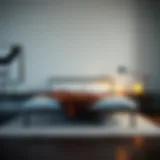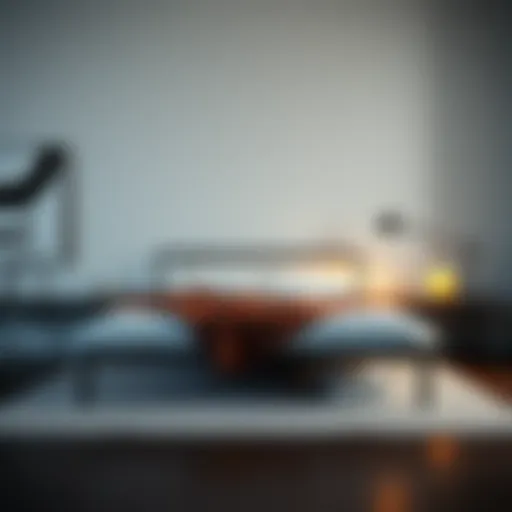Exploring Bendable Ceiling Curtain Tracks: Design & Functionality
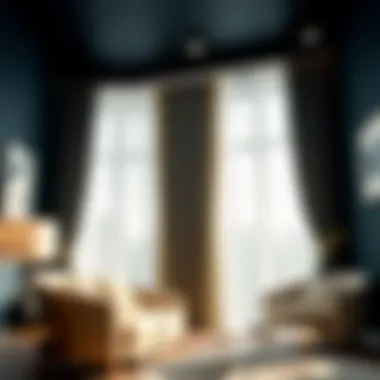

Intro
In the realm of interior design, often the subtle touches make a significant impact. One of these understated elements is the bendable ceiling curtain track, a multifunctional solution that is gaining traction in modern aesthetics. Whether you're dressing up a spacious suite in a hotel or adding coziness to your living room, these tracks offer a range of possibilities that blend functionality with style.
Bendable curtain tracks are not just a passing trend; they represent an evolution in how we think about space and privacy. With the right design, these tracks can seamlessly adapt to curved walls or any custom layout, offering unique solutions for various environments. Enthusiasts, designers, homeowners, and even DIYers should take note of this innovative approach to window and room separation solutions.
This article examines the functionalities, materials, and design considerations linked to bendable ceiling curtain tracks. By exploring both the practical and aesthetic aspects, we can provide insights that illuminate how these systems can enhance both residential and commercial settings.
We will also touch on design trends that align with these tracks, making it easier to integrate them into existing spaces. Let’s dive in and unravel the impact of bendable curtain tracks on contemporary spaces.
Foreword to Ceiling Curtain Tracks
Ceiling curtain tracks may seem like a minor detail in the vast realm of interior design, but they play a crucial role in shaping a room’s ambiance and functionality. These tracks can transform any ordinary space into one that’s visually appealing and practical. At their core, these systems provide a means to hang curtains, which serve not just decorative purposes, but also functional roles, like controlling light, providing privacy, and enhancing insulation.
Definition and Overview
A ceiling curtain track is a system mounted to the ceiling that allows curtains to slide open and closed smoothly along a designated path. Unlike typical curtain rods, ceiling tracks offer the advantage of versatility. They can bend, curve, or be shaped to fit various ceiling dimensions and room designs. Materials commonly employed in their construction include aluminum, plastic, and even wood, each providing distinct features and benefits.
These systems can accommodate a wide range of curtain types, from sheer materials allowing natural light to filter through, to heavier drapes that block out light and provide warmth.
Importance in Interior Design
The significance of ceiling curtain tracks extends beyond mere aesthetics. When utilized effectively, they facilitate dynamic spatial arrangements and can make rooms appear larger or more intimate, depending on the desired effect. Imagine a small dining area transformed by sheer curtains that allow sunlight to cascade in while maintaining some level of separation from adjacent spaces.
Moreover, the choices regarding the design of ceiling curtain tracks can align with the overall theme of a space, be it modern, rustic, or minimalist. For instance, a sleek, aluminum track might complement a contemporary aesthetic, while a wooden track could lend warmth to a traditional room.
"In many cases, it is the subtle elements, like curtain tracks, that tie a room together, adding coherence to a well-conceived design."
Ultimately, understanding and selecting the right ceiling curtain track system can be a game-changer for homeowners and designers alike. It allows for a blend of functionality and personal expression in creating atmospheric spaces that cater to individual lifestyles. Whether it’s the practicality of space optimization or the ability to incorporate bold design choices, the importance of ceiling curtain tracks cannot be understated. Their role is foundational in urging spaces to evolve and accommodate diverse needs, thereby making them an essential consideration in the layout of any interior.
Understanding Bendable Curtain Tracks
Bendable curtain tracks offer flexibility that traditional tracks simply cannot match. This innovative design allows for curvier, more creative installations, making it possible to adapt to varying architectural features. Homeowners and designers alike appreciate how these tracks can transform a space, accommodating unique shapes and layout challenges. Beyond aesthetics, understanding the functionality of bendable tracks ensures that the right choice is made for both form and function in any environment.
What Makes Tracks Bendable
Bendable tracks are engineered using a combination of materials and design techniques that afford them the ability to be curved without compromising their integrity. The secret lies in their construction; they often contain a series of joints or flexible segments that encourage movement. This flexibility enables designers to create flowing lines in spaces, breaking free from the rigid formality of straight tracks.
In practical terms, this means that whether outfitting a cozy corner of a living room or encircling a whole room, these tracks can seamlessly follow the contours of the architecture, enhancing the overall flow of the design. The right bending technique and the quality of materials play a pivotal role in ensuring that these tracks perform well over time without losing their shape.
Materials Used in Construction
The construction materials of bendable ceiling tracks vary, each with its own merits and drawbacks. Here’s a closer look at three popular options:
Aluminum
Aluminum is highly favored in the construction of bendable curtain tracks due to its lightweight nature combined with high strength. This metal offers a sleek appearance and a modern touch to any room. One of the key characteristics of aluminum is its resistance to corrosion, which is significant for durability, especially in humid environments such as bathrooms.
Its unique feature lies in its ability to be effortlessly bent while retaining structural integrity. However, it’s worth noting that while aluminum tracks can handle substantial weight, they might not be as rigid as other materials when it comes to larger installations, which is something to bear in mind during planning.
Plastic
Plastic tracks are another contender in this arena, often regarded for their affordability and versatility. They are typically available in a variety of colors and styles, catering directly to the taste of the user. The most significant advantage of using plastic is its resilience against moisture, hence its popularity in damp settings.
Nevertheless, plastic tracks may not have the same longevity as aluminum and can warping over time if not handled properly. While flexibility is a strong suit, they may require more careful installation to ensure that they perform effectively in the long term.
Wood
Wooden bendable tracks bring a unique warmth and character to interior spaces. Their key characteristic is the natural beauty they bring to a room, enhancing aesthetics in ways that metal or plastic cannot. The rustic charm of wood offers a familiar and comforting look, making it a popular choice for traditional and cozy designs.
However, wooden tracks require careful maintenance, as they are susceptible to moisture damage and warping. They can also be heavier, which may necessitate additional support during installation. That being said, their unique appearance and customizable finishes can elevate a room to new heights, making them a beautiful choice given the right application and care.
Choosing the right material depends largely on the specific demands of the space and the desired aesthetic.
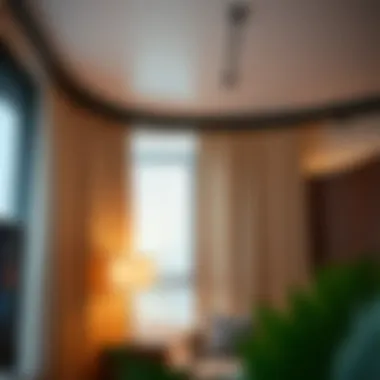

In summary, understanding the different aspects of bendable ceiling tracks lays a solid foundation for making informed decisions. The unique properties of aluminum, plastic, and wood each contribute to how effectively these tracks can be used in various environments, ultimately enhancing both style and functionality.
Advantages of Bendable Ceiling Tracks
Bendable ceiling curtain tracks offer a variety of advantages that make them essential in modern interior design. They provide solutions that are not only functional but also aesthetically pleasing, catering to a wide range of settings, from residential spaces to commercial environments. The main benefits of these tracks can be distilled into three categories: flexible design options, space optimization, and ease of installation.
Flexible Design Options
When it comes to design, flexibility is key. Bendable ceiling tracks allow for a level of creativity that traditional tracks simply can't match. Homeowners and designers can shape these tracks around architectural features such as curved walls or alcoves, making it possible to create visually striking presentations.
- Customization: You can customize the curve of the track to fit any room layout or design theme. For instance, if you have a unique space like a circular room or a large bay window, bendable tracks will accommodate this with ease.
- Material Choices: Available in different materials like aluminum and plastic, they can blend seamlessly with the interior decor. Whether you want something sleek and modern or more traditional, bendable tracks can meet those needs.
- Color Coordination: With various finishes available, it is easy to color-match the track with the curtains or the overall room theme, enhancing visual cohesion.
This adaptability ensures that no matter the design challenge, bendable curtain tracks can provide a practical solution without compromising style.
Space Optimization
In today's world, where space is often at a premium, efficient use of real estate takes precedence. Bendable curtain tracks are excellent space-savers, particularly for small rooms or areas with odd dimensions.
- Maximized Functionality: These tracks can easily accommodate multiple curtain layers or shades, providing privacy and light control without overwhelming your space.
- Full Coverage: Unlike traditional tracks that may require more straight-line arrangements, bendable tracks can follow wall contours. This maximizes the usable area by allowing curtains to cover windows fully, even those in less accessible corners.
- Versatile Room Dividers: They can effectively function as room dividers in open-space designs, providing separation while still maintaining an open feel.
Bendable ceiling tracks not only elevate the aesthetic of a room but also play an integral role in its functionality, enabling optimized spaces that feel complete yet unconfined.
Ease of Installation
Installation should not be a cumbersome process, and bendable ceiling curtain tracks simplify this greatly. These tracks are designed to be user-friendly, making it easier for DIYers and even inexperienced installers to achieve professional-looking results.
- Lightweight Materials: Most bendable tracks are made from lightweight materials, meaning they can be handled with minimal effort and don’t require excessive structural support, making them suitable for a variety of ceiling types.
- Simple Tools Needed: With just a few tools—such as a drill, screw, and measuring tape—you can install these tracks without the need for specialized equipment. Many products even come with comprehensive guidelines to facilitate the process.
- Adjustable Features: Adjusting the curvature and length of bendable tracks is a straightforward process. This means you can modify your setup as needed without extensive rework.
With these easy-to-follow steps and designs that can adapt to almost any setting, homeowners and designers alike can conquer even the trickiest installation scenarios.
Bendable ceiling curtain tracks are the transformative element in any decor, allowing homeowners and designers to create elegant spaces that adapt to their needs.
In summary, the advantages of bendable ceiling tracks extend far beyond mere functionality. They blend practical solutions with creativity, offering unique, flexible options for any space, while being easy to install and maintain.
Design Considerations
When contemplating bendable ceiling curtain tracks, design considerations play a crucial role in ensuring not just functionality, but also visual appeal. The integration of these tracks into any space requires a thoughtful approach as they can heavily influence the overall aesthetic and purpose of a room.
Style and Aesthetic Integration
Choosing the right bendable track is about more than just its practical use; it’s also about how it complements or contrasts with existing decor. If you're aiming for a contemporary look, sleek aluminum tracks might work wonders, while a vintage theme may call for wooden tracks that exude charm. The style of your curtains should also harmonize; flowing fabrics work well with softer, curved tracks. A stark track paired with heavy drapes can seem somewhat discordant. Think of it this way: the curtain track is the unsung hero of your decor, quietly holding everything together without stealing the limelight.
Keep in mind that colors matter. Neutral shades tend to blend well, while bolder choices can stand out, drawing attention to the tracks themselves. It's all about what you want to achieve in your space.
Tips for Integration:
- Assess the overall interior theme. Avoid mismatches.
- Consider the room’s function. A formal living room may call for elegance while a playroom could embrace more vibrant options.
- Don’t skimp on flexibility. Design in a way that accommodates changing styles or seasonal decor.
Choosing the Right Curtains
Selecting the ideal curtains to hang on bendable tracks is a fundamental aspect of achieving that polished look. The choice of fabric, texture, and color can either ‘make or break’ the design scheme. For instance, heavier fabrics can provide drama and warmth but may not slide as easily along a bendable track. On the other hand, lightweight materials like sheers glide effortlessly and allow for more light filtering.
It's also critical to take functionality into account. Are the curtains strictly decorative, or do they need to block out light? Customize the length and width according to the space to ensure proper fitting, as poorly sized curtains can cheapen the overall effect.
**Consider the following questions:
- What purpose will the curtains serve? (e.g., privacy, light control)
- How often will the curtains be opened or closed? (curtain weight could affect this)
- Are there any specific patterns or colors that echo throughout the space?**
Ultimately, integrating a bendable track with the right curtains can create a dynamic interplay of textures and colors, enhancing both functionality and style. By paying attention to these considerations, you can transform any space into an aesthetically pleasing and practical environment.
Installation Techniques
The installation of bendable ceiling curtain tracks is a critical aspect that directly influences both functionality and design. Proper installation ensures that the curtains glide smoothly, allowing users to efficiently manage light and privacy in their spaces. This section will cover essential tools needed for the installation and provide a step-by-step guide to help homeowners and DIY enthusiasts navigate the process with confidence.
Tools and Equipment Required
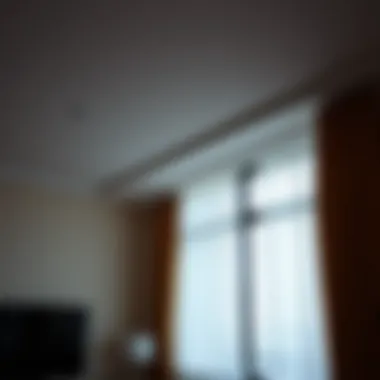

When preparing to install bendable ceiling curtain tracks, having the right tools and equipment can make the entire process significantly easier and more efficient. Here’s a rundown of what you’ll need:
- Measuring Tape: Accurate measurements are crucial, as you'll need to determine the exact length of the curtain track based on your space.
- Level: This is used to ensure that your curtain track is installed straight and at the correct angle.
- Drill: A power drill is essential for creating holes in the ceiling, allowing for secure fastening.
- Screwdriver: Choose the right type – typically, a Phillips or flat head will be most suitable for the screws used.
- Pencil: Marking points on the ceiling will help you keep track of where to drill and mount the track.
- Curtain Track End Caps: These are usually included with the track and are necessary for preventing the curtains from slipping off.
- Brackets: These hold the track in place and must be securely attached to the ceiling.
- Curtains or Drapes: The final touch, make sure these match your design vision.
Step-by-Step Installation Process
Installing bendable ceiling curtain tracks does not have to be daunting; follow this straightforward process to ensure a successful installation:
- Measure the Space: Use the measuring tape to determine the length of the curtain track, making sure to account for any bends needed if you plan to curve the track around corners or architectural features. This step is pivotal; an ill-measured track can lead to fitting issues.
- Mark the Ceiling: Lightly mark your desired track placement on the ceiling with a pencil. Take into account your curtain’s drop length and desired positioning.
- Install Brackets: Begin by securing the brackets to the marks you've made on the ceiling. Drill holes where necessary and insert anchors if mounting on drywall. Ensure that each bracket is level before finalizing the screws.
- Attach the Track: With the brackets in place, slide the curtain track onto each bracket. Make sure it fits snugly without any slipping. Check for levelness once more.
- Secure the Track: Once satisfied with the positioning, tighten any screws to lock the track onto the brackets. Use end caps to finish off the ends of the track, preventing any curtains from sliding off.
- Hang the Curtains: Start by attaching your curtains or drapes to the track. Depending on the track type, this may involve clips, hooks, or simply sliding them onto the track.
- Final Adjustments: Step back and assess the whole setup. Adjust any curtains as needed to ensure a full aesthetic satisfaction.
Cooperative installation can often yield better results. If possible, enlist a friend to hold the track in place while you secure the brackets.
This methodical approach, combined with the right tools and a bit of patience, will lead to a successful installation of your bendable ceiling curtain track. Once installed, you can appreciate the ability to effortlessly change the ambience of your space with ease.
Functional Applications
Understanding the functional applications of bendable ceiling curtain tracks is crucial for those looking to optimize their interior spaces. These tracks are not just about aesthetics; they serve a pragmatic purpose that can enhance utility and comfort in both home and commercial settings. With their flexibility and adaptability, they can cater to various design needs while improving the overall functionality of a room.
Residential Uses
Bendable ceiling curtain tracks open up a world of possibilities for residential spaces. Whether you live in a cozy apartment or a spacious house, these tracks can be tailored to fit unusual architectural features or unique room layouts. For instance:
- Curved Walls: In homes with rounded or curved walls, standard curtain rods simply won't cut it. Bendable curtain tracks can be shaped to follow the contour, ensuring that curtains hang beautifully without gaps. This adds a touch of elegance and can improve insulation as well.
- Room Separation: In open-concept homes, bendable tracks can be employed to create temporary partitions. This allows homeowners to transform a living area into a more private space when needed, without the necessity for permanent walls. Think family gatherings or movie nights; you can easily divide the room for those cozy moments.
- Drapery Options: Homeowners can explore a variety of fabrics and colors, allowing for creative expression. From sheer curtains that filter sunlight to blackout options for bedrooms, the choices are abundant. Moreover, curtains on bendable tracks can facilitate easy opening and closing, which is especially beneficial for larger window areas.
Ultimately, these tracks not only enhance the style of a home but also contribute to its functionality, offering a practical solution to everyday challenges.
Commercial Applications
In commercial settings, the need for versatile and functional design is paramount. Bendable ceiling curtain tracks become indispensable tools in various industries:
- Hospitality Industry: In hotels, these tracks can effortlessly transition from elegant drapery in suites to functional partitioning in conference rooms. They can help with space management, allowing for quick adjustments based on specific requirements for events or meetings.
- Showrooms and Retail Spaces: Stores can utilize bendable tracks to create dynamic displays. Whether highlighting a new collection or crafting a unique shopping experience, these tracks can guide the customer’s journey throughout the space, providing both visual interest and practicality.
- Healthcare Facilities: In hospitals, using bendable tracks to create private spaces within rooms ensures patient comfort without compromising the accessibility that is so crucial in medical environments. Curtains can provide privacy during examinations and treatments, contributing to patient dignity and comfort.
By understanding these applications in both residential and commercial contexts, it becomes clear that bendable ceiling curtain tracks not only add beauty but also offer significant utility. Their flexibility makes them a sought-after choice for design professionals and business owners alike, ultimately shaping the way spaces are utilized.
Maintenance and Care
Maintaining bendable ceiling curtain tracks is not just a matter of aesthetics; it ensures their functionality and longevity. Keeping these tracks in good shape contributes to the overall efficiency of the curtains, enhancing the space's look and feeling. With varying usage in residential and commercial settings, the focus should be on regular upkeep to avoid any unwarranted performance issues.
Cleaning Recommendations
Maintaining cleanliness around bendable curtain tracks is paramount. Dust and grime can quickly accumulate, leading to wear and tear. Here are some tips for keeping your tracks spotless and functional:
- Use a Soft Cloth: Opt for a microfiber cloth to gently wipe down the tracks. This minimizes scratches and captures dust effectively.
- Mild Cleaning Solutions: Mix warm water with a few drops of dish soap to create a gentle cleaning solution. Avoid harsh chemicals that could discolor the tracks.
- Regular Dusting: Make it a practice to dust the tracks at least once a month. Just a quick wipe can help maintain their appearance and function.
- Inspect Curtain Sliding Mechanism: During your cleaning routine, observe the curtain gliders for any signs of wear or blockage that might impede movement.
- Lubricate Moving Parts: A silicone-based lubricant can help in ensuring smooth movement of the curtains. Apply it sparingly to the glider wheels or clips to avoid buildup.
Troubleshooting Common Issues
Even the best-maintained bendable ceiling tracks can run into occasional problems. Recognizing these issues early can save both time and aggravation later on. Here’s a list of common complications and how to resolve them:
- Curtain Won't Slide Smoothly: If the curtains are catching or becoming difficult to slide, check for debris in the track. A quick cleaning often resolves this issue. If the problem persists, the gliders may need replacing.
- Tracks Warping or Bowing: Extreme heat or humidity can warp your curtain tracks. Ensure they are not exposed to direct heat sources and consider using thermal insulation if located in high-temperature areas.
- Squeaking Sounds When Moving Curtains: This often indicates the need for lubrication. A light application of silicone spray or liquid paraffin between the contact points can quiet them down.
- Curtains Falling Off Tracks: If this occurs, inspect the end stops and ensure they are correctly in place. Given that these tracks are more flexible, regular checks are prudent to keep everything in position.
- Visible Damage: Dents or scratches can sometimes be fixed with touch-up paint, but if the damage is severe, replacing the section might be necessary.
"Regular maintenance can prolong the life of your ceiling curtain tracks, saving both time and money in the long run."
By integrating these maintenance practices into your routine, you not only maintain the visual appeal of your space but also ensure that your bendable ceiling curtain tracks function optimally for years to come. Remember, a little preventive care goes a long way!
Comparative Analysis
When selecting ceiling curtain tracks, understanding the differences between various types of tracks can greatly influence not just aesthetics, but also functionality. A detailed comparative analysis between bendable and traditional tracks highlights significant distinctions that every homeowner, designer, or DIY enthusiast should consider.
Bendable vs. Traditional Tracks
Bendable tracks have gained popularity due to their flexibility and adaptability, especially in spaces requiring custom shapes or curves. In contrast, traditional straight tracks generally cater to standard window sizes and linear designs. Here are a few key distinctions:
- Flexibility: Bendable tracks can be molded to fit any space. Whether it’s a rounded room or a unique architectural feature, they can curve seamlessly around corners. Traditional tracks, however, typically require precise measurements and do not accommodate irregular shapes well.
- Installation Ease: Installing bendable tracks can be more straightforward when fitting to non-standard window shapes, given their ability to adjust to varying contours. In contrast, installing traditional tracks often demands precise alignment, which can be a headache if measurements are off.
- Aesthetic Appeal: When it comes to design, bendable tracks allow for more creative applications. Homeowners or decorators can implement unique curtain layouts that enhance the visual interest of a room. Traditional tracks may limit creativity to simple designs, often sticking to a straightforward appearance.
In terms of performance, bendable tracks offer distinct advantages in certain environments, such as high-traffic areas or open-concept spaces where curtains might need to span large distances or create partitions dynamically. Traditional tracks excel in their robust nature and long-lasting features, ideal for consistent and straightforward designs.
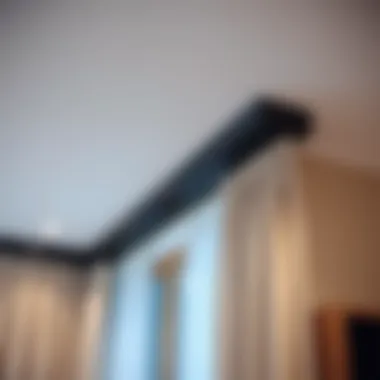

Cost Considerations
The cost of implementing bendable ceiling curtain tracks versus traditional ones can be a significant deciding factor for many. While the price of bendable tracks might lean higher due to their advanced design and materials, the long-term benefits can justify the initial investment. Here are some considerations:
- Initial Costs: Bendable tracks can often be pricier than traditional alternatives. This includes not just the tracks themselves, but also potential installation costs that may arise from needing professional help for custom fittings.
- Longevity and Durability: Although bendable tracks might come with a steeper price tag, they may outlast traditional tracks, especially in dynamic environments. They resist wear better in settings where the curtains are frequently pulled back and forth, leading to less frequent replacements.
- Value Addition: Unique curtain tracks can enhance the overall appeal of a space, which can translate into increased property value. Homeowners looking to sell might find that these features attract buyers, making bendable options worthwhile.
Innovative Trends in Ceiling Curtain Design
The realm of ceiling curtain design has undergone a remarkable evolution in recent years. It's not just about hanging fabric anymore; it has transformed into a fusion of technology, style, and functionality. This section explores the innovative trends that are reshaping the way we perceive and implement bendable ceiling curtain tracks in our spaces. Understanding these trends is crucial for homeowners, designers, and anyone interested in optimizing their environment with customized solutions that blend aesthetics with practicality.
Sustainable Materials
Sustainability is more than a buzzword; it’s a necessity in today’s design landscape. When it comes to ceiling curtain tracks, sourcing eco-friendly materials has become a priority. Traditional tracks were often made from metals or plastics that aren’t environmentally friendly. However, today’s innovations include the use of
- Recycled metals: Aluminum that has been recycled minimizes the carbon footprint while remaining durable.
- Bio-based plastics: Derived from natural sources, these materials decompose more easily compared to their petroleum-based counterparts.
- Bamboo and wood alternatives: Sustainable wood options can provide a natural aesthetic without harming forests.
By opting for these materials, you not only reduce your environmental impact but also enhance the visual appeal of your interior spaces. The use of sustainable materials serves as a testament to the commitment of homeowners and designers towards a greener future.
"Choosing sustainable materials is not just a trend, it’s a way to shape a better world while enjoying living spaces that resonate with our values."
Smart Home Integration
As technology continues to integrate itself into every aspect of our lives, ceiling curtain tracks are no exception. Smart home integration allows for seamless control of curtain tracks, providing convenience and enhanced functionality. This trend is characterized by:
- Automated control systems: Imagine opening or closing your curtains with a single tap on your smartphone or through voice commands. Smart tracks can be connected to home automation systems like Google Home or Amazon Alexa.
- Sensors for enhanced functionality: Some systems come with light sensors, automatically adjusting the curtain position based on sunlight, optimizing energy usage in your home.
- Customization options: Homeowners can tailor their experiences by setting schedules for when curtains should open or close, ensuring privacy when necessary while maximizing natural light during the day.
The blend of smart technology with bendable tracks highlights a shift towards intelligent living spaces. It provides not just ease of use, but also a step towards futuristic homes that prioritize efficiency and comfort.
Incorporating these innovative trends into ceiling curtain design reflects a broader commitment to personalizing spaces while considering sustainability and technology. For homeowners and designers alike, staying abreast of these advancements can yield remarkable transformations in interior environments.
The Future of Bendable Ceiling Tracks
As we peer into the road ahead for bendable ceiling curtain tracks, we can’t help but marvel at their potential implications for interior design as well as their functional capability. The importance of this topic lies not only in the continuation of innovation but also in the transformative experiences these tracks can deliver in both home and commercial spaces. As flexibility becomes increasingly vital in modern design, the future of bendable ceiling tracks seems poised for growth and reinvention.
Emerging Technologies
Looking beneath the surface of bendable ceiling tracks, we find a world where technology intertwines seamlessly with aesthetic appeal. The innovations on the horizon hold promise for both material enhancements and improved operational functions. For instance, manufacturers are now experimenting with advanced materials that result in tracks that are lighter yet infinitely more durable. There’s potential in smart technology as well, with tracks featuring built-in sensors that could adjust based on lighting and occupancy, making them part of a broader smart home ecosystem.
Additionally, 3D printing has begun to influence the design of custom bendable tracks. Imagine being able to have tracks crafted to perfectly fit any curve or configuration, all while maintaining structural integrity. This technology could further revolutionize the DIY market, enabling homeowners to mold their own curtain tracks at home, tailored to their personal requirements.
Market Trends
It’s fascinating to analyze current trends in the market that drive the evolution of bendable ceiling tracks. We might see a substantial uptick in demand for sustainable and eco-friendly materials. Consumers are increasingly leaning toward products that reflect a commitment to the environment, so manufacturers that prioritize recyclable materials and low-impact production processes may have an edge.
As remote work continues to reshape living spaces, the functionality of these tracks has expanded beyond the conventional. An uptick in multifunctional spaces drives interest in versatile design solutions.
- Homeowners may opt for bendable tracks that allow for a swift transition from open-plan living to cozy, segmented spaces.
- In commercial areas, flexibility is key. Space is often at a premium, and businesses are keen on solutions that maximize utility without compromising style.
"The market for bendable ceiling tracks is only set to expand. As trends shift towards sustainability and greater flexibility, those tracks that adapt to these needs will stand out."
In summary, the future of bendable ceiling tracks holds much promise, intertwined with both innovative technologies and evolving market trends. As we shift into this new era of design, these tracks are likely to become a staple in creating flexible and functional spaces that cater to the nuanced demands of modern living.
The End
As we conclude our journey through the world of bendable ceiling curtain tracks, it becomes clear that these seemingly simple installations are anything but ordinary. They embody a blend of practicality and creativity, allowing for a design flexibility that traditional tracks simply can’t match. The analysis provided throughout the article highlights not just their utility, but also the aesthetic potential they unlock in any space.
Summary of Key Points
In revisiting the significant points covered:
- Definition and Variety: Bendable curtain tracks are engineered to follow the contours of walls, creating dynamic spaces where common straight tracks fall short. Their ability to adapt to various designs makes them versatile for both residential and commercial settings.
- Material Choices: We explored various materials such as aluminum, plastic, and wood, each offering unique benefits in terms of weight, durability, and design formalities. These options ensure that users find a track suitable for their specific needs, be it lightweight or robust.
- Advantages: The adaptability of bendable tracks enhances interior space optimization, contributing to smarter living environments. Additionally, their installation process, although requiring some basic tools, is straightforward enough for DIY enthusiasts.
- Design Considerations: Style integration is a critical component, as these tracks can be seamlessly mixed with different types of curtains, providing a creative outlet for homeowners and designers alike.
- Future Prospects: Emerging technologies and trends, like sustainable materials, suggest that the industry is moving towards more eco-friendly solutions, and smart home compatibility, making these tracks an even more integral part of modern design.
Overall, the significance of bendable ceiling tracks lies in their multi-functionality and adaptability, making them an essential element in contemporary interior design and functionality.
Final Thoughts on Bendable Tracks
Ultimately, considering bendable ceiling tracks translates to embracing innovation in our spaces. They represent not just a trend, but a shift towards more thoughtful and customized living environments. Whether it's transforming a room's ambiance with curves or implementing efficient space use amenities; these tracks negotiate both practicality and innovation.
As a designer, homeowner, or furniture enthusiast, understanding the full scale of what bendable ceiling curtain tracks can offer is paramount. Misjudging this element could mean missing out on a cornerstone of modern design flexibility. Thus, whether you're embarking on a home renovation, sprucing up a commercial setting, or simply scouting for effective solutions for your living space, bendable tracks are undoubtedly a worthwhile consideration.
For further exploration, consider resources like Wikipedia, Britannica, or join discussions on platforms like Reddit and Facebook. These can provide additional insights and inspiration, enriching your understanding of bendable ceiling curtain tracks and their impact on space management and design.








